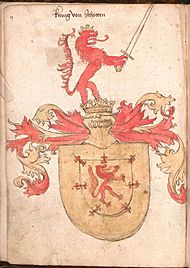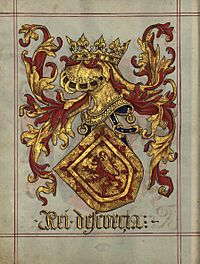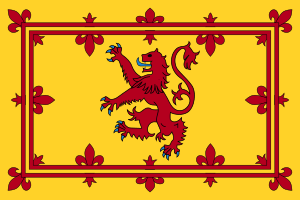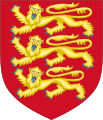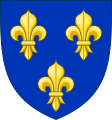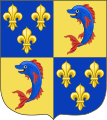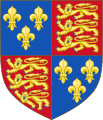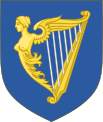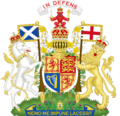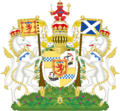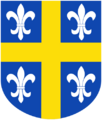Coat of arms of Scotland facts for kids
Quick facts for kids Royal Arms of Scotland |
|
|---|---|
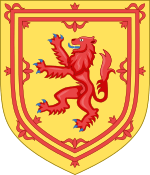 |
|
| Versions | |

Heraldic tabard and caparison
|
|

Banner of arms, which serves as the royal standard
|
|
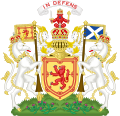
Achievement
|
|
| Armiger | Monarchs of Scotland |
| Adopted | Late Middle Ages |
| Blazon | Or a lion rampant Gules armed and langued Azure within a double tressure flory-counter-flory of the second |
| Motto | Scots: In My Defens God Me Defend (abbr. In Defens) |
| Use |
|
The royal arms of Scotland are the official coat of arms used by the King of Scots. They were first used in the 12th century and are still one of the most famous national symbols of Scotland.
The flag version of these arms is a special privilege. The First Minister of Scotland is allowed to use it, as granted by the monarch. Today, these Royal Arms are often called the Royal Banner or simply the Lion Rampant.
When James VI became King of England and Ireland in 1603, Scotland shared a ruler with these kingdoms. The Scottish arms were then combined with the arms of England and Ireland. Even after Scotland and England joined to form Great Britain in 1707, the royal arms used in Scotland remained different from those used elsewhere.
The arms are sometimes beautifully described as "the ruddy lion ramping in his field of tressured gold." They are still widely used today as a symbol of Scotland. You can see them combined with the arms of England and Ireland in the royal coat of arms of the United Kingdom.
Contents
What do the Royal Arms look like?
The Royal Arms of Scotland have several important parts. Each part has a special meaning.
The Lion and the Tressure
The main part of the arms shows a red rampant lion. This means the lion is standing on one back leg with its front paws raised, ready to strike. It has a blue tongue and blue claws. This lion is inside a red double border that is decorated with fleurs-de-lis. This special border is called the royal tressure.
People used to think the fleurs-de-lis showed a friendship between Scotland and France. However, this friendship started much later than when the tressure was added to the arms. It was probably added to make the Scottish arms stand out more. Many other lords and kings also used a rampant lion symbol.
The Crown, Helmet, and Motto
Above the shield, there is a helm and a crest. The helmet is gold and has six bars. It has gold mantling (fabric) lined with ermine (a type of fur).
On top of the helmet sits the crest. This shows the red lion again, but this time it's facing forward and sitting on the Crown of Scotland. The lion is wearing the Crown of Scotland and holding the Sceptre and the Sword of State. These are part of the Honours of Scotland, which are the Scottish crown jewels.
Above the crest, you will see the slogan "In Defens". This is a shorter way of saying "In My Defens God Me Defend". The word defens is the Scots language spelling of "defence."
Around the shield, there is a collar from the Most Ancient and Most Noble Order of the Thistle. This is a very old and important group in Scotland.
The Unicorn Supporters
Two crowned and chained unicorns stand on either side of the shield. These are called "supporters." The unicorn on the right (from the shield's point of view) holds a flag with the royal arms. The unicorn on the left holds the national flag of Scotland.
Unicorns were seen as powerful and dangerous beasts, which is why they are always shown chained. Over time, the arms changed only a little. Sometimes, the lion in the crest didn't hold a sceptre, or the unicorns didn't wear crowns.
The Thistles
At the bottom of the arms, there is a compartment (a base) with several thistles. The thistle is the national flower of Scotland. Later versions of the arms also included a blue ribbon over the thistles. On this ribbon, in gold letters, is the motto of the Order of the Thistle: Nemo me impune lacessit. This Latin phrase means "No one provokes me with impunity."
How did the Royal Arms change over time?
The Royal Arms have a long history, changing as Scotland's story unfolded.
Early History of the Arms
A version of these arms was first used by King William the Lion in the 12th century. We can clearly see a rampant lion on the seal of his son, Alexander II. Some old writers even claimed the lion symbol was much older, used by a legendary king named Fergus.
Over the years, the arms were passed down from one monarch to the next. There were only small changes. Sometimes the lion held a sword or wore a crown. These small differences often came from artists or stonemasons trying to copy the arms.
During the reign of James III, the Scottish Parliament tried to remove the double border (royal tressure). They passed a law saying the king should only have the lion. But this didn't last long, and James III soon brought the royal tressure back.
Scotland and England Unite
| Royal coat of arms of Scotland | |
|---|---|
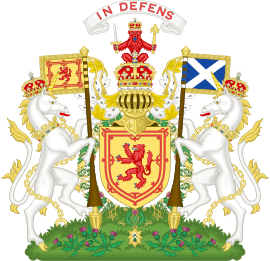 |
|
| Versions | |
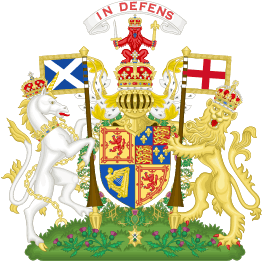
Coat of arms of James VI from 1603 as both the King of Scots and as King James I of England, France, and Ireland.
|
|
| Armiger | James VI, King of Scots, ultimate armiger of pre-1603 version |
| Adopted | Late Middle Ages |
| Crest | Upon the Royal helm the crown of Scotland Proper, thereon a lion sejant affronté Gules armed and langued Azure, imperially crowned Proper holding in his dexter paw a sword and in his sinister a sceptre, both Proper |
| Blazon | Or a lion rampant Gules armed and langued Azure within a double tressure flory-counter-flory of the second |
| Supporters | Unicorns Argent imperially crowned Proper, armed, crined and unguled Or, gorged with a coronet of the second composed of crosses patée and fleurs de lis a chain affixed thereto passing between the forelegs and reflexed over the back also of the second. Sinister holding the standard of Saint Andrew, dexter holding the banner of the Royal arms |
| Compartment | a compartment underneath from which issue thistles one towards each side of the escutcheon |
| Motto | Scots: In My Defens God Me Defend (abbr. In Defens) |
| Order(s) | The Most Ancient and Most Noble Order of the Thistle. (Arms feature the collar of the order) |
When James VI became King of England and Ireland in 1603, the Scottish arms were combined with those of England and Ireland. At this time, the King of England also claimed the French throne, so the English arms already included French symbols. James used a different version of his royal arms in Scotland, and this continued even after the Acts of Union in 1707. Today, the Royal Arms of the United Kingdom used in Scotland are still different from those used elsewhere.
Adding the Thistle Motto
During the time of King Charles II, the royal arms used in Scotland got a new addition. The Latin motto of the Order of the Thistle, "Nemo me impune lacessit", was added. This motto appears on a blue scroll (a decorative ribbon) over the thistles. Before this, only the collar of the Order of the Thistle was shown on the arms.
This addition made sure that the Scottish royal arms had two mottos, just like the royal arms used elsewhere. The other royal arms had the French motto "Dieu et mon droit" ("God and my right") and the motto of the Order of the Garter, "Honi soit qui mal y pense" ("Shame on him who thinks evil of it").
Since 1603, the Royal Arms have also included the harp of Ireland. The style of the harp has changed over the years. Even after Ireland became a republic, the modern Royal Arms of the United Kingdom still show an Irish harp to represent Northern Ireland.
The Royal Arms as a Flag
After the Kingdom of Great Britain was formed, the Scottish arms are usually seen combined with the arms of England and Ireland. However, the original royal banner of Scotland, also known as the "Lion Rampant," is still officially used in Scotland.
You can see it flying from royal homes when the King is not there. It is also used by important officials like the First Minister of Scotland and Lord Lyon King of Arms. Unofficially, the royal banner is often used as a second national flag. You might see it at sports events where Scottish teams are playing. For example, the Scottish Football Association uses a logo based on the royal arms.
Where are the Royal Arms used today?
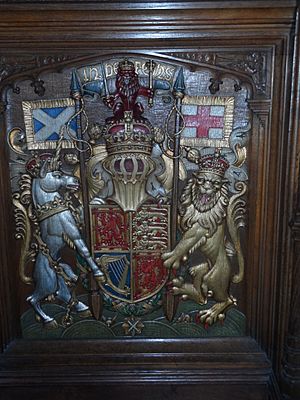
The current design of the royal arms was adopted when Queen Victoria became queen in 1837. In this design, the Scottish arms are in the first and fourth sections of the shield. The English arms are in the second section, and the Irish arms are in the third.
The Scots motto "In Defens" is still there, just like in the original arms. The Latin motto of the Order of the Thistle, "Nemo me impune lacessit", is also on a blue scroll over the thistles. The Scottish unicorn and English lion hold flags of St Andrew and St George. The unicorn is on the right side, which is the more important position. The shield is surrounded by the collar of the Order of the Thistle.
Royal Family and Government
The arms of the Duke of Rothesay (which is a title for the heir to the Scottish throne, currently Prince William) combine the arms of the Great Steward of Scotland with the arms of the Lord of the Isles. In the middle, there are the royal arms of Scotland with a special three-pointed label.
The coat of arms of Gibraltar also includes the Scottish arms in the second section of its shield. It uses the unicorn as a supporter on the left side. The royal arms of Canada also feature the Scottish arms in the second section and use the unicorn as a supporter.
Other Countries and Cities
Both the flag and arms of Nova Scotia (a province in Canada) have parts of the Scottish arms. Their arms show the unicorn as the crowned supporter on the right, in the Scottish style. The shield shows a reversed flag of Scotland with the Royal arms of Scotland in the middle.
The royal tressure (the double border with fleurs-de-lis) is found on the arms of many Scottish families and groups. This shows that they received special favour from the monarch. For example, the cities of Perth and Aberdeen have it in their arms.
The arms of the Archdiocese of Mechelen in Belgium used to be the same as Scotland's. They were later combined with the arms of Brussels. One idea is that their patron saint, Saint Rumbold, was an Irish monk, and Irish monks were sometimes called "Scotii" in old times. Another idea is that Saint Rumbold was the son of a Scottish King.
The coat of arms of the town of Sankt Wendel in Germany also combines parts of the Scottish flag and arms. Four lilies from the Scottish royal arms on a blue background remind people of Saint Wendelin. Legend says he was a Scottish king's son. In 1465, the town even sent people to Scotland to check this story. After they supposedly confirmed it, the Scottish lion arms were used in the town's seal.
Images for kids
-
Arms of England
-
Arms of France
-
Arms of the Dauphin of France
-
Arms of Ireland
-
Arms of the House of Orange-Nassau
-
Arms of the House of Hanover
-
Arms of King Charles III used in Scotland
-
Arms of Prince William, Duke of Rothesay used in Scotland
-
Arms of the Province of Nova Scotia
See also
 In Spanish: Escudo de Escocia para niños
In Spanish: Escudo de Escocia para niños
- Honours of Scotland
- Scottish heraldry
- Court of the Lord Lyon
- Unicorn (coin)




